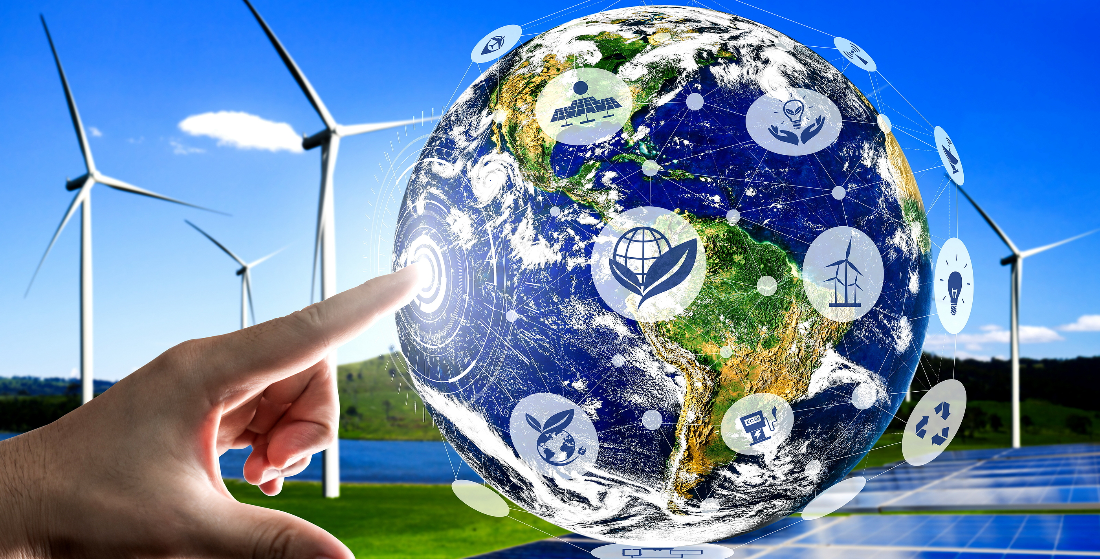The energy transition: It’s not easy being green
Increasing pressure is being put on lenders to drop hydrocarbon projects, but this is much easier said than done and a proper transition period allows for all parties to develop sustainable alternatives. Jonathan Bell assesses some of the issues.

In October 2019 when a few Extinction Rebellion supporters got on top of a London underground train early one morning preventing the train from pulling out from the platform and also preventing many people from getting to work there was naturally intense outrage at such crass action. Why did they do it? Shock tactic? Im still trying to work that one out, after all these are trains powered by electricity not coal! Of course it certainly made the headlines, but probably lost the movement a certain degree of support.
As someone born and brought up in the north-east of England, and with coal miners on both sides of my family in generations long past, I was outraged by the actions of the Thatcher government in the early 1980s in its wholesale assault on coal mining communities throughout the country. This was much more political than economic in the UK’s case, and long before any other EU country tackled coal mining/coal-fired power stations from an economic or even climatic point of view. Fast forward 40 years and the current UK government is considering approval of a new coal mine to supply coking coal to the country’s steel industry – replacing coking coal currently being imported.
But through the first two decades of the 21st century climate change, global warming and sustainability have become THE major talking points as we look to try to arrest further destruction of planet earth, and in line with the Paris climate agreement to get to net zero carbon emissions by 2050. Of course every country is at a different stage in this journey which is why there will be various stages of transition, not just in the production of energy but across many other industrial sectors from concrete and steel production to electric vehicle manufacturing.
For some financing institutions it seems to be easy to make the jump. Most global commercial banks have declared they will no longer finance coal. On the development bank front, the European Investment Bank (EIB) in November announced its new energy lending policy and declared that it would stop financing for all fossil fuel (including gas) energy projects by the end of 2021. This is a year later than the EIB had originally proposed though following lobbying by EU member states. In addition, as of the end of last year the EIB is aligning all financing activities with the goals of the Paris agreement. This is admirable, but a much easier decision for the Luxembourg-based ‘climate bank’ than for most other financiers. For many though it’s not easy being that ‘green’!
At the time of the announcement, EIB president Werner Hoyer said: “Climate is the top issue on the political agenda of our time. The EU bank has been Europe’s climate bank for many years. Today it has decided to make a quantum leap in its ambition. We will stop financing fossil fuels and we will launch the most ambitious climate investment strategy of any public financial institution anywhere.”
Going greener than green?
A previous review of energy lending in 2013 had already enabled the EIB to be the first international finance institution to effectively end financing for coal and lignite power generation. And between 2015-2020 the EIB provided more than €65 billion ($78 billion) of financing for renewable energy, energy efficiency, and energy distribution. The EIB is also aiming to support €1 trillion of investments in climate action and environmental sustainability in the critical decade from 2021 to 2030.
So, the EIB is involved in a transition period, albeit a very short one, only up to the end of this year! Hence the December 2020 decision to provide a €76 million 15-year financing facility for the €152 million 160 MW combined-cycle gas turbine (CCGT) power plant at Vasilikos in Cyprus. This new CCGT plant will replace a heavy fuel oil plant.
The bank is forging ahead of course with many renewable energy projects but is also financing a range of sustainable industries which are cutting edge and probably worth a mention here. One such landmark deal from last year which is highly significant for the European automotive industry is the $350 million financing that the EIB has agreed for the Northvolt ETT li-ion battery gigafactory in Sweden. This $1.6 billion project has involvement from four export credit agencies (ECAs) – Euler Hermes of Germany, Bpifrance, Nexi from Japan and South Korea’s Kexim. The credentials of this financing has led it onto the shortlist of deals of the year transactions at TXF.
Also in the same sector in 2020, the EIB signed a €125 million loan with Umicore of Belgium for a greenfield battery materials production facility in Poland. This covers half of the cost of the new plant. And just last week the EIB announced a €50 million financing to Forsee Power of France for electric battery development. Unsurprisingly support for the electric battery production sector is a key element in the EIB’s drive to help reduce CO2 emissions.
ECAs and commercial banks have a bigger challenge
Compared to development and multilateral banks, commercial banks and ECAs have a much tougher route to navigate as they live in a world where clients need financing and territories such as emerging markets are a big part of that mix. But at the same time these institutions are increasingly under the media and consumer spotlight in a world where increasingly the mention of hydrocarbons financing of any sort and certain heavy industry financing can lead to adverse publicity, reactions from investors and potential reputational risk.
So intense has this issue become that I now see some commodity/corporate financings being done where a bank does not want any publicity at all of any kind on deals related to energy in particular, and in some cases will not even say that it is one of the financiers within a syndicate even though it is well known to be a relationship bank of a certain company. One such example has just come my way of a big financing where the corporate even flags the deal up itself as a so-called ‘green’ financing! In this case green meaning a range of sustainable-like key performance indicators (KPIs) giving the financing ‘green’ credentials.
So called ‘greenwashing’ in the trade and commodity finance world has been an issue for some time. Over the past few years as journalists we have often battled with companies simply unprepared to support their ‘green’ financing claims by providing information on how and by whom supposedly sustainable KPIs are being monitored or evaluated. Ok, ‘first-world’ problem some might say, but it actually isn’t, it is applicable everywhere as we move forward with assessing ESG and SDG requirements. Rather cynically perhaps I wonder if we have to go through a time frame where the fudging or clouding of ‘green’ takes place before we get to true emerald green! My problem!
ECA-backed green deals trending
But on the ECA-backed financing front it is clear that more transactions are having SDG criteria applied, and this is very noticeable in many of the ECA deal of the year submissions that have come through this year where they follow the ‘green loan principles’ of the Loan Market Association (LMA).
One such example is a $258 million financing signed in July 2020 for the supply of MAN manufactured ‘green’ buses to Saudi Arabia. The ECA involved is Euler Hermes and the MLAs are Credit Agricole and HSBC. The transaction is the first ever ECA-supported loan to the Ministry of Finance in the country. This deal is compliant with green loan criteria of the LMA.
Also in the transport sector is a 2020 $417 million green loan deal for shipping company Hapag-Lloyd. The financing supports the construction and purchase of three ultra-large LNG/dual fuel enabled container vessels from Daewoo Shipbuilding & Marine Engineering. The dual fuel enabled container vessels are part of Hapag-Lloyd’s aim to modernise its fleet and reduce its environmental footprint. The green loan framework is backed by third-party assessors.
That financing is backed by South Korea’s K-Sure. Banks involved include BNPP, KfW IPEX-Bank, Bank of America, Citi, Credit Agricole, DekaBank, Deutsche Bank, HSBC, ING Bank, SMBC and Societe Generale.
In the energy supply sector, a $743 million green loan ECA-backed financing was signed in April 2020 for borrower National Grid North America for the Viking Interconnector Denmark-UK subsea cable project. This deal represented the first time multiple ECAs (Euler Hermes and Sace of Italy) had come together to finance a green project of this size. This deal was also National Grid’s debut green loan under its green financing framework. MLAs on the deal were BNP Paribas, HSBC and National Westminster Bank.
Emerging market transitioning
Going forward the big issue for ECAs and commercial banks will continue to be that of whether to finance hydrocarbon projects in emerging markets. There is going to be increasing pressure applied to such oil and gas upstream and downstream projects. And in the UK, where the government is considering approving the new £165 million ($228 million) coking coal mine in Cumbria, it is also threatening to stop UKEF, the country’s ECA, from funding overseas hydrocarbon projects. My opinion is that this would be a massive mistake as LNG projects are very much part of the energy transition to the ultimate goal of net-zero carbon by 2050.
One only has to look at the largest energy project of last year – LNG Mozambique – to understand what economic significance this has for such a country and also for some of the countries where the resultant gas will be exported. The project itself is a $14.9 billion ECA-backed project financing, with four ECA direct lenders: JBIC ($3 billion), US Exim ($4.7 billion), Thai Eximbank ($150 million), UKEF ($300 million), four other ECAs, as well as loans from Afreximbank, African Development Bank and some 19 commercial bank lenders.
The project will have a significant role in the global energy transition and be a catalyst for upcoming change in the global fuel mix with declining coal and oil sources. With targeted export countries largely based in Asia (China and India in particular) some of the volumes sold by the Mozambique LNG project will be used in power generation to replace coal and oil which will lower carbon emissions globally. Such FDI is transforming a market such as Mozambique and the contribution to the energy transition is certainly helping pave a ‘greener’ path in many ways.
Become a TXF subscriber for unrestricted access to TXFnews.com 365 days a year
Contact us for individual and team rates by emailing subscriptions@txfmedia.com
Take a look below at a selection of exclusive subscriber articles published last week
Smile Telecoms: Lenders grimace as debt restructuring begins
Smile Telecoms is looking to restructure its DFI/ECA-backed debt package from 2015. But the pan-Afircan telecoms groups, which is no stranger to ECA debt, was struggling to service its payment obligations long before the pandemic hit.
Akbank nears refi launch
Akbank is set to kick off the Turkish bank trade finance on-lending funding year with a refinancing of the $603 million-equivalent loan it raised in April 2020. The facility will be launched into syndication within two weeks.
Hapag-Lloyd taps debut green facilities for six new ships
German container shipping company Hapag-Lloyd has broken new ground with a $889 million green financing package for six new ships.
Banks in for Mining Industry Indonesia’s up to $750m loan
Government-run holding company Mining Industry Indonesia is in the process of structuring a facility of up to $750 million, divided into a five-year $500 million tranche and a three-year $250 million greenshoe option.
Chilean desal plant funding progresses
Sponsors of a $1.3 billion desalination plant in Northern Chile - Marubeni and Transelec - are re-examining contracts for the scheme with lenders and the offtaker, with EPC and debt negotiations progressing.
PGS restructures $300m ECA-backed loan
Norwegian marine services provider Petroleum Geo-Services (PGS) has undergone a restructuring of its $305 million ECA-backed facility from 2014. The two lenders, SMBC and JBIC, have granted a grace period of two years in exchange for amended cash sweep provisions as part of a broader restructuring on PGS’s part.





